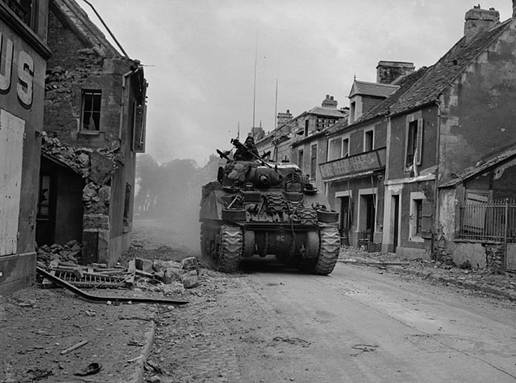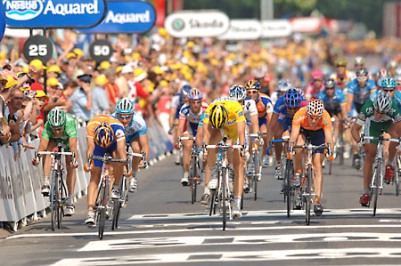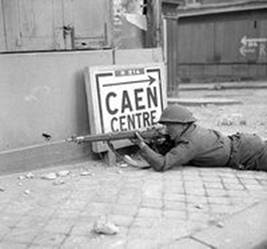CyclingRevealed's First Impressions '06
Stage 5, July 6th, Beauvais to Caen, 225 km
The Race to Caen
At 6:00AM on June 6, 1944 (D-day) my late father-in-law was in the first wave of soldiers to land on Sword Beach (British sector). Within the first hour 200 (out of one thousand) of his comrades were either killed or seriously injured. George made it off the beach in his Bren-gun carrier and his orders were to "race to Caen" to help secure the city. On his way to Caen George and his comrades briefly participated in the famous battle for the double bridge over the Caen Canal and River Orne that run side by side from Caen to the coast. Now known as Pegasus Bridge in honor of the airborne division that landed at the bridge, this key objective was secured later on D-Day as George continued his race for Caen . He reached the outskirts of the town but the British were driven about halfway back to the coast where they set up a defensive post. It was not until August that intense allied bombing dislodged the German defenders and George fought his way past Caen , over the Seine river and eventually through Belgium and the Netherlands into Germany . By the time George entered ‘the Fatherland' only 200 soldiers from the original 1000 of his regiment remained in fighting condition. Nearly 40 years later I had the great honor to Tour the Normandy beaches with George and the specific sites where he had fought. To this day it remains as one of my most memorable and moving experiences.

In 1944 Caen was reduced to rubble (Archive)
The Tour has approximately traced George's WW2 route from Valkenburg (Stage 3) to Caen (but of course in the opposite direction). Seeing Caen today it is hard to imagine that about 80% of this once beautiful medieval city was reduced to rubble. It took 14 years to rebuild it to the way we see it today.
While Normandy may best be known for its role in WW2 the region is also notable for other memorable historical events. In 1066 William the Conquerer sailed from Normandy to Hastings in England where he battled with King Harold who was famously felled with an arrow in his eye. William became King of England and the course of British history was changed for ever. The story of those times is depicted in the famous ‘Bayeaux Tapestry' which can be seen in Bayeaux not far from Caen .
For cycling, the most famous Norman of all is Jacques Anquetil. He was born not far from today's route and following his racing successes became a ‘gentleman farmer' in the area. High on his list of exceptional results is his record as the first five-time Tour de France winner.
As has been the way of the Tour this year, the race started today with a flurry of attacks. After many combinations of cut and thrust racing Samuel Dumoulin (AG2R-Prevoyance) and Björn Schröder (Milram) made their attempt stick at 37kms. With 188km to go this suited the sprinters teams just fine because they knew that the wide open coastal roads near Caen would be very windy and most certainly cause the elimination of the break.
Meanwhile back in the bunch Robbie McEwen and Tom Boonen continued their ‘head games'. Boonen holds the Yellow Jersey and McEwen leads the point's competition as signified by his Green Jersey. Long term neither man is expected to figure in the race for GC. The battle for Green however is a completely different story. To preserve his point's buffer over Boonen, McEwen sent his teammate (Johan Vansummeren) up the road at three intermediate sprints to claim the remaining points. This both denied Boonen the chance to contest for them as well as allow McEwen an easy ride to the finish. At the finish McEwen could both win the stage and take the Yellow Jersey with it depending on Boonen's placing in the sprint. The real fight for GC starts with Saturday's time trial but for now the Green Jersey competition is in full fury.
The two man break scared the peloton with their courageous riding. With 5km to go they still had 15 seconds but it was all over 2km later. The intense chase shredded the peloton and gave cause to a big crash. The big boys and many of their teammates came through unscathed. Two km to go and Liquigas and Quick. Step was driving for the line. Boonen was fifth in line with McEwen glued to his wheel. Boonen exploded for the line and it was agonizing to watch him fight a huge gear in a desperate effort. But once again he was beaten on the line for second. This time it was three-time World Road Race Champion Oscar Friere who won the race for Caen . McEwen was fifth and held on to the Green Jersey while Boonen retained the Yellow Jersey.

Oscar Freire wins in Caen [ Image ©: www.gazzetta.it ]
The WW2 battle for Normandy was pivotal in the outcome not only of the war but for the future of the world. Had Hitler prevailed and driven the Allies back into the sea we would today be living in a very different world. Most probably we would not be enjoying the Tour or many of the other things that we take for granted. If George and the many hundreds of thousands of soldiers, sailors and airmen who fought in those dramatic times were still with us today they would most certainly have enjoyed watching the peaceful arrival of the Tour into Caen . The race to Caen has been won.

Unlike 1944, the reception in Caen today was extremely friendly and enthusiastic (Archive)
Tomorrow: the race continues westwards through Normandy from Lisieux to Vitre, 184 km. Come back to CyclingRevealed.com for our daily impression.
Return to Tour ToC >>> Previous Stage >>> Next Stage >>> |
